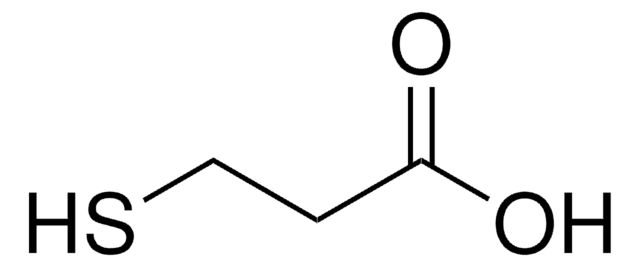QBD10247
Thiol-dPEG®4-acid
>95% (HPLC)
Sinônimo(s):
Carboxy-PEG4-thiol, HS-PEG4-COOH, Thiol-PEG-acid, Thiol-PEG4-COOH, Thiol-PEG4-acid
Faça loginpara ver os preços organizacionais e de contrato
About This Item
Fórmula empírica (Notação de Hill):
C11H22O6S
Peso molecular:
282.35
Número MDL:
Código UNSPSC:
12352106
NACRES:
NA.22
Produtos recomendados
Ensaio
>95% (HPLC)
forma
solid or viscous liquid
adequação da reação
reaction type: Pegylations
arquitetura do polímero
shape: linear
functionality: heterobifunctional
Condições de expedição
ambient
temperatura de armazenamento
−20°C
Características e benefícios
Thiol-dPEG4-acid is a sulfhydryl-containing, crosslinking PEGylation reagent that has a cross-bridge of monodisperse polyethylene glycol. The single molecular weight, discrete-length PEG (dPEG) chain is 16 atoms (18.3 Å) long. The sulfhydryl end of the crosslinker reacts with gold (forming dative bonds) and with thiol-reactive functional groups such as maleimide, bromoacetyl, SPDP, and thiol. The carboxylic acid end of the molecule couples to free amines using EDC or any suitable carbodiimide. An acylating agent such as N-hydroxysuccinimide (NHS) or 2,3,5,6-tetrafluorophenol (TFP) can enhance coupling efficiency. The carboxylate must react after the sulfhydryl conjugation.
Informações legais
Products Protected under U.S. Patent #s 7,888,536 & 8,637,711 and European Patent #s 1,594,440 & 2,750,681
dPEG is a registered trademark of Quanta BioDesign
Código de classe de armazenamento
11 - Combustible Solids
Classe de risco de água (WGK)
WGK 3
Ponto de fulgor (°F)
Not applicable
Ponto de fulgor (°C)
Not applicable
Certificados de análise (COA)
Busque Certificados de análise (COA) digitando o Número do Lote do produto. Os números de lote e remessa podem ser encontrados no rótulo de um produto após a palavra “Lot” ou “Batch”.
Já possui este produto?
Encontre a documentação dos produtos que você adquiriu recentemente na biblioteca de documentos.
Pi-Chou Hsieh et al.
BioMed research international, 2017, 5041683-5041683 (2017-05-02)
Herein, we report a method of combining bioinformatics and biosensing technologies to select aptamers against prostate specific antigen (PSA). The main objective of this study is to select DNA aptamers with higher binding affinity for PSA by using the proposed
Carrie A Simpson et al.
ACS nano, 5(5), 3577-3584 (2011-04-09)
Monolayer-protected gold nanoparticles have great potential as novel building blocks for the design of new drugs and therapeutics based on the easy ability to multifunctionalize them for biological targeting and drug activity. In order to create nanoparticles that are biocompatible
Daichi Okuno et al.
Analytical sciences : the international journal of the Japan Society for Analytical Chemistry, 32(12), 1353-1357 (2016-12-13)
The artificial bilayer single-channel recording technique is commonly used to observe detailed pharmacological properties of various ion channel proteins. It permits easy control of the solution and membrane lipid composition, and is also compatible with pharmacological screening devices. However, its
Nossa equipe de cientistas tem experiência em todas as áreas de pesquisa, incluindo Life Sciences, ciência de materiais, síntese química, cromatografia, química analítica e muitas outras.
Entre em contato com a assistência técnica






![O-(3-Carboxypropyl)-O′-[2-(3-mercaptopropionylamino)ethyl]-polyethylene glycol Mw 3000](/deepweb/assets/sigmaaldrich/product/structures/271/277/d02536f0-83d7-4416-9cea-f6213e09fe85/640/d02536f0-83d7-4416-9cea-f6213e09fe85.png)
